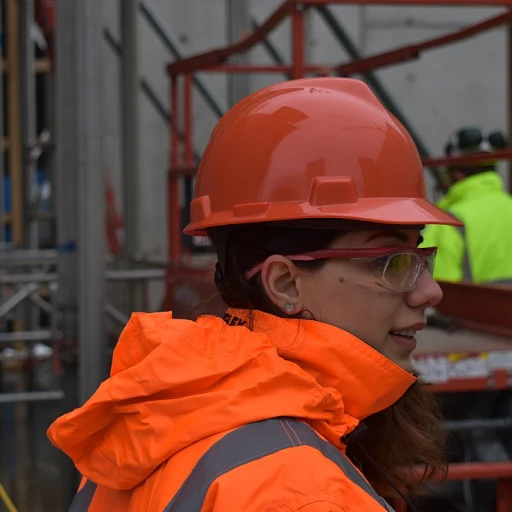
Understanding Career Architecture
Exploring the Foundations of Career Architecture
Understanding career architecture is essential for organizations aiming to build a structured career framework. This concept provides a structured approach that aligns jobs, roles, and responsibilities within an organization. It enables clarity in career paths and helps in managing talent effectively. Career architecture revolves around defining clear job levels and roles that outline employee career progression. Companies use job architectures to establish job families that group similar types of work. This framework helps in creating comprehensive job descriptions that are vital for employees to understand their current roles and future roles' possibilities. Essentially, career architecture not only focuses on the immediate job structure but also paves a way for long-term career development. It assists in workforce planning by aligning the needs of the business with the skills and competencies of employees, ultimately ensuring pay equity and fair compensation practices. Organizations benefit by having a well-defined job architecture, which supports effective talent management and boosts organizational performance. For more insights into how technology is reshaping career structures, including workforce planning, consider exploring advanced e-learning practices in HR which are transforming current models.The Role of Technology in Career Architecture
Harnessing Technology for Career Growth
In the landscape of organizational development, technology plays a pivotal role in crafting effective career architectures. It serves as a foundational pillar in facilitating streamlined processes and enhanced functionality across various sectors of the company. By leveraging technology, organizations can create comprehensive frameworks that support the systematic development of job architectures and career paths.
Advanced job architecture systems provide robust platforms for organizations to align their job descriptions, job families, and job titles effectively. This alignment enables seamless integration of roles, responsibilities, and compensation across different job levels. Additionally, utilizing technology-driven solutions helps in managing job leveling and pay equity, ensuring fair compensation for employees across the board.
Furthermore, technology aids in developing efficient talent management systems that support employee growth and career progression. These systems assist in identifying skills and competencies necessary for various roles and help track the development of these competencies through targeted training programs. By employing technology in this way, businesses can focus on precise workforce planning, thereby enhancing overall organizational efficiency.
Various tools and platforms now allow companies to personalize the career development experience for employees, taking into account individual aspirations and organizational needs. This personalized approach ensures that employees find fulfilling career paths that align with their skills and career ambitions, ultimately leading to a more motivated and productive workforce.
For a deeper insight into the synergy between HR technology and career architecture, you might explore how leading organizations like McDonald's are adapting to the future of human resource management.
Benefits of Career Architecture for Employees
Empowering Employees Through Structured Career Paths
Career architecture, when effectively implemented within an organization, provides tangible benefits for employees that extend well beyond their immediate roles. By offering a structured framework, this strategic approach enhances career progression, allowing employees to visualize potential career paths based on their skills and interests. Employees gain access to a clear career framework comprising clearly defined job families and job levels. This structured job architecture fosters an understanding of roles and responsibilities, influencing career development positively. Moreover, it eliminates ambiguities in job descriptions and compensations, guiding employees toward potential growth opportunities within the organization. Pay equity is another notable benefit stemming from career architecture. With well-defined job descriptions and job leveling, there is greater transparency in compensation, ensuring that employees are rewarded equitably for their work based on their roles. This transparency promotes a sense of fairness and motivates employees to strive toward specified goals, resulting in increased job satisfaction and retention. Talent management also experiences a transformative impact. By aligning career paths with the organization's strategic vision, companies can proactively develop their workforce. This approach facilitates effective workforce planning, helping organizations to optimally utilize their talent pool for future success. For a deeper dive into enhancing workforce capacity planning, consider exploring this comprehensive guide on enhancing workforce capacity planning for future success. A well-designed career architecture thus not only empowers employees by providing clarity and development opportunities, but also enables organizations to retain talent and sustain competitive advantages in today's dynamic business landscape.Organizational Advantages of Career Architecture
Organizational Growth through Career Architecture
Career architecture significantly contributes to organizational development by establishing structured frameworks for job roles and leveling. By outlining clear career paths and job descriptions within an organization, companies can master workforce planning more effectively and enhance their talent management strategies. Structured job architectures enable businesses to align skills and roles responsibilities, optimizing job performance. Moreover, career frameworks assist in defining job families and job levels, ensuring equitable compensation packages and ensuring pay equity across the board. A systematic approach to career progression, enabled by job level definitions and classified roles, ensures that employees understand the expectations and responsibilities tied to their positions. Additionally, organizations that implement career architecture can anticipate change by consistently analyzing and adapting to the evolving career development landscape. This forward-thinking approach aids in identifying and cultivating emerging talent pools, effectively managing job architecture adjustments as the company's needs develop. As businesses evolve, career paths within the organization transform, reflecting job market trends and industry demands. This adaptability helps organizations remain competitive and attract top-tier talent, fostering long-term success.Challenges in Implementing Career Architecture
Addressing Challenges in Crafting Effective Career Architecture
Crafting an effective career architecture is not without its hurdles. Organizations often encounter several challenges that need careful consideration to ensure successful implementation. As companies strive to enhance career progression pathways and development opportunities, understanding the nuances of challenges is critical. Firstly, the complexity of aligning job architectures with job families and job titles can be daunting. Organizations must ensure that roles and responsibilities are clearly defined, facilitating a detailed, consistent job leveling across the entire organization. This involves articulating job descriptions that align with the overarching career framework while maintaining clarity in job family relations. Such intricacy in detailing roles can be overwhelming but is necessary for effective workforce planning. Another significant challenge lies in maintaining pay equity across different roles and job levels. Companies must assess compensation packages to ensure fair pay practices within the architecture. This often requires periodic reviews and adjustments to management approaches, taking into account both market dynamics and internal equity considerations. Additionally, fostering an adaptable organizational culture that accommodates evolving career paths can pose a challenge. Employees need to be motivated and engaged in pursuing new opportunities within the career architecture framework, yet cultural inertia or resistance to change can hinder this progression. It requires proactive management to encourage a development-focused mindset. Moreover, harnessing technology to support the architecture while ensuring business alignment can prove difficult. As organizations integrate technological solutions, like superior e-learning platforms, ensuring that these tools seamlessly support job architecture objectives is vital. However, organizations must balance technological adoption with maintaining personalized human touch in career development. Finally, there’s the challenge of talent management. Ensuring that the career architecture supports talent retention and progression requires a strategic approach. It means developing a comprehensive, dynamic career path with plentiful opportunities for skill enhancement and role advancement. Such efforts help retain top talent but demand detailed planning and continuous management. These challenges, while formidable, present opportunities for organizations to refine their approach, contributing to a robust career architecture that supports both employee and organizational growth.Future Trends in Career Architecture
Emerging Trends in Career Development Architecture
As we continue to witness dynamic shifts across the globe, career development architecture is set to evolve in several intriguing ways. Companies are diligently exploring various methodologies to enhance job architecture and workforce planning to align with modern needs. Here's a glimpse of the future trends shaping this field:- Advanced Skill Mapping: Organizations are increasingly utilizing data-driven approaches to thoroughly map skills essential for different roles. This implies a more robust alignment between job descriptions and the practical skills of employees, allowing for more accurate job leveling and career path development.
- Integrating AI and Machine Learning: These technologies are progressively becoming integral to creating adaptive career frameworks. They offer predictive insights into training needs, skill gaps, and potential career progression pathways, enabling more targeted talent management strategies.
- Emphasis on Flexible Career Paths: With the concept of static career ladders becoming obsolete, organizations are crafting flexible career architecture to address diverse career aspirations and lifestyles. This involves creating various career paths within job families that accommodate lateral moves as well as advancements.
- Focus on Pay Equity: As businesses consistently strive for fairness and inclusivity, ensuring equitable compensation across all job levels within the career architecture framework will remain a significant trend. This not only aids in retaining talent but also enhances organizational reputation.
- Remote and Hybrid Work Models: The rise of remote work necessitates reevaluating roles and responsibilities. Companies are adjusting job architectures to reflect the new nature of work environments, which impacts how roles are executed, measured, and compensated.












